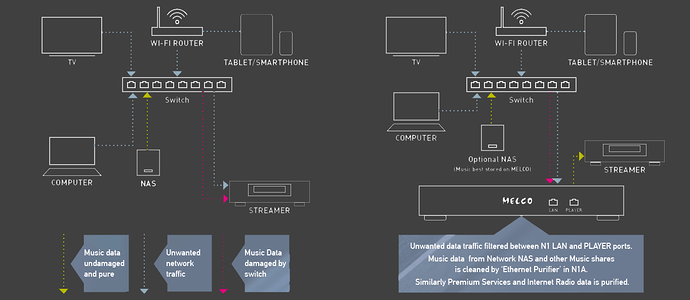(I promise, I tried to stay away from this thread  )
)
Before anyone decides to spend £1,999 (!) on an Ethernet switch, I seriously urge proper due diligence.
Here’s a starting point:
The Melco S100 is built on the back of a single Broadcom BCM53342 SoC, ancillary support circuits, BothHands GH5210-LF quad Ethernet port line-transformers, a power supply, and a pretty chassis.
(Image credit:
Lowbeats)
From a data integrity standpoint - in both bit/packet accuracy, and timing - there’s absolutely nothing that the S100 does that can’t be had for under $200 from elsewhere. In fact, the D-Link DGS-1210-08P uses the exact same chip architecture and offers the exact same port configuration for £95.99 
If you’re worried about data integrity on your home LAN, here’s a quick way to verify that you have no issues; using Roon when it shows “Signal Path: Lossless” that means complete bit-perfect stream end-to-end from your Server right into your dCS component - Roon’s RAAT embeds data integrity validation to ensure bit transparency end-to-end (regardless of any Ethernet cables or Switches/Routers in between!).
If noise or grounding or weak/damaged digital bit voltage levels are causing bits/packets to be altered or misinterpreted in any way by your dCS component (thats the only way you can perceive sound quality changes in a digital streamed playback chain) then Roon/RAAT will let you know via the Signal Path function that your bitstream is not lossless (if you’re still unconvinced, I’ll explain other methods to verify data integrity in a separate post elsewhere sometime in the near future).
As to the “purify” discussion, I’m afraid that’s just pure marketing speak. In the Melco context it could possibly refer to two things;
-
The individually isolated Ethernet ports via separate (Marvell) Ethernet chips on their N1x-series Servers - which is defeated as soon as you switch the Server into “Network mode” (necessary to stream from Qobuz/Tidal) as the two ports are then completely bridge at that point. The benefits of Melco Server’s “Direct Mode” is purely theoretical, dCS component are not bothered in the least by miscellaneous LAN traffic on its port not directly addressed to it.
-
The discrete Ethernet port transformers (TDK pulse-transformers on the N1x Servers and the BothHands ones on the S100), but every Ethernet switch comes with balanced transformers on the Ethernet ports (often referred to as “Magnetics” - discrete or otherwise), that ensures high levels of common-mode noise rejection to ensure data integrity, it’s part of the Ethernet physical interface standard!
Ultimately, if you’re still worried about ground noise getting into your dCS components from your Ethernet switch, say, via the tiny amounts of parasitic capacitance on the Ethernet port transformers, then go full optical isolation; with something like a Mikrotik CRS309 with non-blocking 8 x 1G/10G SFP+ ports for a mere $238.60, and populate the switch with SFPs of your choice for complete optical isolation between all key components on your LAN.
No doubt Melco products are well built physically/ergonomically - as a matter of fact, I have an N1x Server in my system - but you really should know exactly what you’re paying for before you buy it. If you like the S100’s aesthetics, and can’t think of a better way to spend £1,999, then by all means knock yourself out, but don’t imagine it does anything extra special to improve data integrity.
Disclosure: I work for an Ethernet switch manufacturer.
 .
.
 )
)
